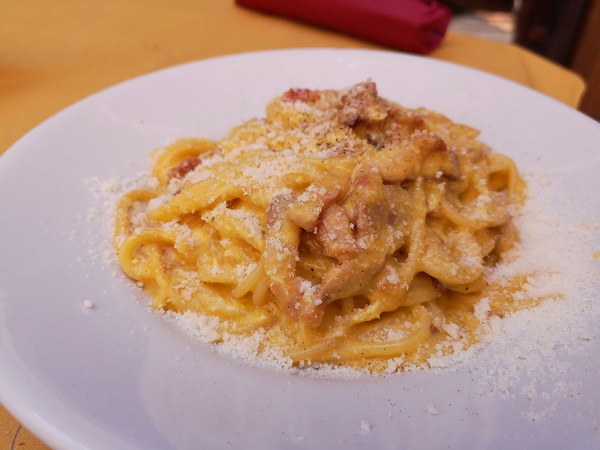Fun facts about Italian food: interesting tidbits and Italian food facts for curious eaters and Italy lovers!
Food is a big deal in Italy.
It is at the center of gatherings with family and friends, a huge part of our tourism industry and export and one of the things we Italian are most obsessed with.
The saying goes that Italians are the only people who talk about food while eating food and indeed, we do!
Italian food is a large part of our culture and while we are not all foodies, we do tend to have strong opinions about it and we love to share facts about Italian food with others.
The are many fun facts about Italian food, some to do with its origins, and some with the way we eat so today I thought of putting them all together.
I hope this list of fun facts about Italian food will make you smile, teach you something and will also help get rid of some Italian food myths that are stubborn but have no basis in Italian culture!
Love pinterest? Save this post!

Interesting and fun facts about Italian food
Did you know that….
Pizza Margherita owns its name to Queen Margherita of Savoy
Pizza Margehrita is the queen of all pizzas and not just because of its popularity.
Pizza Margherita owns its name to an actual Queen, Queen Margherita of Savoy, for whom this pizza was first prepared.
The story tells is the Neapolitan chef Raffaele Esposito, in charge of creating a meal for the queen, wanted to make a patriotic dish for her.
He therefore came up with the idea of a pizza with the colors of the Italian flag: red (tomato sauce), white (Mozzarella) and basil, the colors of the Italian flag!
Want to know more about Italy, its tradition and history? Don’t miss this article with fun facts about Italy for kids!
World Pizza Day happens on the 17th of January
Pizza is so belovged around the world it has is own day: the 17th of January!
Neapolitan Pizza is Unesco intangible World Heritage
Pizza comes in several variations (thin, thick, even fried) but the pizza you eat in Naples, made according to tradition, is so special, UNESCO declared the art of making it intangible heritage!
Indeed, there is nothing quite like it and if you are lucky enough to taste the real thing, it is hard to go back and enjoy anything else!
You don’t have pizza and pineapple in Italy
Pizza with pineapple is popular abroad but you cannot get it in Italy and many will look at you in horror at the mere mention.
Italians are relaxed about many things but food is not one of them and pizza and pineapple somehow is completely unacceptable
Pizza with Nutella is delicious
Pizza is delicious if dressed with Nutella, pizza con Nutella being the perfect marriage of two Italian success stories.
The type of pizza you use is, of course, without tomato sauce or cheese.
It is a tastier variation of bread and Nutella, which is the most common way to eat the popular italian chocolate spread.
There are over 300 shapes of pasta sold in Italy
Pasta is the main staple of the Italian diet and it comes, literally, in all shapes and sizes.
At present, you can buy over 300 types fresh (pasta all’uovo) and dry (the one you find in boxes in the supermarket)!
Italy produced over 3 tons of pasta each year
Italians love pasta and also export vast amounts of it.
In Italy, the most popular type of long pasta is spaghetti while penne and rigatoni are the mosy common short shapes
The most common type of pasta Italians eat at home is the short shaped one, especially penne, rigatoni, fusilli and farfalle.
There are rules about pairing pasta shapes and sauce
In Italian restaurants you cannot pick and choose the shape of pasta you prefer.
Rather, it is the chef who decides what pasta format is best for the sauce they are using.
This is why you find trofie al pesto and not ‘pasta al pesto’ or ‘fettuccine al ragu’ rather than ‘pasta al ragu’.
Whilte there is more freedom at home, many Italians keep the rules when cooking for themselves too.
As a general rule, short pasta is for milder sauces that you don’t mind biting into while stronger tastes like pesto is better on long shaped pasta.
The thin coating giving a better, more subtles taste than a dollop of pesto all concentrated in one ‘rigatone‘!
You don’t’ find fettuccine Alfredo in Italy – or do you?
Fettuccine Alfredo are one of the most popular Italian dishes in the USA but one Italians do not know and that you will not find in Italy.
With exceptions!
While tagliatelle Alfredo are almost unknown on Italian menus, they were born in Italy and there is a restaurant in Rome claiming paternity to this dish (I had no idea until I wrote this post and gotr a nice message from the owner telling me about it – how cool is that?).
The restaurant is still in operation and has been declared Historic Shop of Excellence by the Municipality of Roma Capitale: Il vero Alfredo aka Alfredo di Rome is in Piazza Augusto Imperatore 30.
It is also fun to now that the basic preparation of fetttuccine Alfredo with butter and parmesan is a staple for kids in Italy: it is made in all Italian homes and it is called pasta in bianco!
Want to make an Italian dinner for your family? You can find many popular Italian recipes for kids here
Different regions have different pasta specialties
You can eat pasta pretty much anywhere in Italy but some regions have traditional dishes that are unique.

Pesto is best eaten in Genova, Liguria and Cinque Terre,
original ragout (what aborad is called Bolognese) is best eaten in Bologna or in Tuscany (in its Tuscan variation, ragout toscano),
carbonara is quintessentially Roman,
gnocchi alla sorrentina are from Sorrento and the Amalfi Coast and
orecchiette con le cime di rapa are from Puglia, just to name a few!
Regional specialties are a thing
Pasta is not the only thing that varies from region to region.
Risotto alla Milanese is typical of Milan, Risi e bisi and Fegato alla Veneziana are specific from the area of Venice, Arrosticini are from Abruzzo and how can we forget cassata and cannoli, among the most delightful of Sicilian dishes.
Caesar’s salad is Mexican
Caesar Salad is sold in Italy but not as a local specialty as it was not born in Itay but rather in Mexico!
Its creator, however, is said to have been of Italian origins so maybe some connection between Caesar salad and italy does indeed exist.
Prosciutto di Parma is not just ham
Prosciutto di Parma is often called ‘prosciutto crudo’ in Italian (simply raw ham, as opposed to prosciutto cotto, cooked ham) however, not all ham is Parma Ham!
Parma ham is a specific food denomination of a product coming from the region of Parma and known for a particularly important tradition and preparation technique.
The real prosciutto di Parma is protected by EU law and is now a DOP so that only the real thing can be marketed under this prestigious name
Parmigiano Reggiano dates back to the Middle Ages
Parmigiano Reggiano, another made in Italy food now known around the world, has been around for over 9 centuries!
The story goes that it was first created by Benedictine monks in Emilia, the region still famous for its production
Italians drink over 6kg of coffee per year
Italians love coffee and we drink over 6kg of coffee per year!
There are over 149.000 cofes in Italy and they serve on average 175 coffee cups per day!
If you order coffee in Italy you get an espresso
When you order ‘un caffe’ in Italy or ‘a coffee’ you get what aborad is known as espresso, a shot of coffee in a small cup.
You can say ‘espresso’ in Italy too but really, the way to order it is ‘un caffe’ per favore‘ (one coffee please).
It is worth knowing that if you order a ‘latte’ in Italy you will get a glass of milk (latte is italian for milk).
If you want the equivalent of a foreign latte, you need to ask for latte macchiato
Italians do drink cappuccino after 11
Despite what is often found on the web, you can drink cappuccino after 11 in Italy.

While it is a quintessential morning drink, often part of the traditional Italian breakfast, it is very common for people to order it up to early in the afternoon.
It is however less common to have it after dinner, mostly becausethis milky coffee makes it too heavy on the digestion
In Italy you drink coffee after a meal, never with it
Coffee in Italy is drank in the morning or after a meal, never as a accompaniment to it
Breakfast in Italy is a rather small affair
Breakfast in Italy is a rather small meal.
Usually, as a traditional Italian breakfast Italians have coffee with or withour milk (children often have have cocoa milk) with bread butter and jam or biscuits.
Aperitivo was born in Turin
Aperitivo, the Italian tradition of drinks with a light meal before dinner, was born in Turin but gained widespread popularity in Milan
Tomatoes are originally from America
Tomatoes, considered one of the staples of the Mediterranean diet, came to Italy from America.
Garlic bread in Italy has no butter
Garlic bread is another staple in many Italian restaurants aborad however, it is not sold as such in Italy.
What you have in Italy is bruschetta which is grilled bread with garlic an olive oil (plain) or dressed with tomatoes or pates.
Garlic bread in Italy is never served with butter.
Italian gelato is not the same as ice cream
Gelato is not the Italian word for ice crea, but rather, an Italian specialty with peculiar characteristic.

Gelato is less cold than ice cream, nutritious and with less fat. You can read all the differences between the 2 here.
Limoncello is made with lemon peel
Limoncello is one of the most popular Italian liquors and it is made with lemon peel from a specific area of Italy, the Amalfi Coast.
Here, specifically in the town of Minori, you can still see the lemon groves and walk the path the lemon growers used to walk to carry the lemons from the trees to the town!
Tiramisu was born in Treviso – maybe!
It is not entirely clear where Tiramisu was born but the story goes that it was born in Treviso.
Nowadays, you find it almost everywhere in Italy and it is one of the success stories of Italian cuisine
I hope you enjoyed this selection of fun and interesting facts about Italian food. Find more fun facts about Italy here. Buon appetito!

